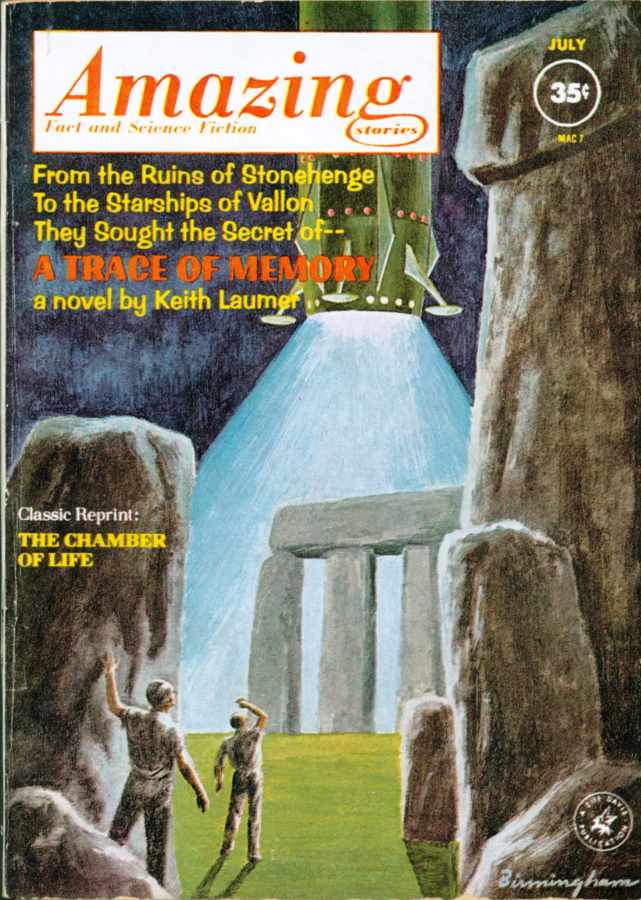Stonehenge is a prehistoric monument on Salisbury Plain in Wiltshire, England, two miles (3 km) west of Amesbury. It consists of an outer ring of vertical sarsen standing stones, each around 13 feet (4.0 m) high, seven feet (2.1 m) wide, and weighing around 25 tons, topped by connecting horizontal lintel stones. Inside is a ring of smaller bluestones. Inside these are free-standing trilithons, two bulkier vertical sarsens joined by one lintel. The whole monument, now ruinous, is aligned towards the sunrise on the summer solstice. The stones are set within earthworks in the middle of the densest complex of Neolithic and Bronze Age monuments in England, including several hundred tumuli (burial mounds). Archaeologists believe that Stonehenge was constructed from around 3000 BC to 2000 BC. The surrounding circular earth bank and ditch, which constitute the earliest phase of the monument, have been dated to about 3100 BC. Radiocarbon dating suggests that the first bluestones were raised between 2400 and 2200 BC, although they may have been at the site as early as 3000 BC. One of the most famous landmarks in the United Kingdom, Stonehenge is regarded as a British cultural icon. It has been a legally protected scheduled monument since 1882. Stonehenge could have been a burial ground from its earliest beginnings. Deposits containing human bone date from as early as 3000 BC, when the ditch and bank were first dug, and continued for at least another 500 years. There is little or no direct evidence revealing the construction techniques used by the Stonehenge builders. Over the years, various authors have suggested that supernatural or anachronistic methods were used, usually asserting that the stones were impossible to move otherwise due to their massive size. The twelfth-century Historia Regum Britanniae (“History of the Kings of Britain”), by Geoffrey of Monmouth, includes a fanciful story of how Stonehenge was brought from Ireland with the help of the wizard Merlin. According to the tale, the stones of Stonehenge were healing stones, which giants had brought from Africa to Ireland.
| Alias Stonehenge |
| Real Names/Alt Names N/A |
| Characteristics Arthurian Cycle, Paranormal Mysteries, Bronze Age |
| Creators/Key Contributors ○ |
| First Appearance Historical site |
| First Publisher ○ |
| Appearance List Archeology: The Most Notable Antiquity of Great Britain, Vulgarly Called Stone-Heng (1655) by Inigo Jones (ed. John Webb) — the first book devoted to Stonehenge; Chorea Gigantum: or, Stone-Heng Restored to the Danes (1663) by Walter Charleton — First ed. 1663, later ed. 1725; A Vindication of Stone-Heng Restored (1665) by John Webb (Architect) — Webb’s 1665 defense of Inigo Jones, discussing “orders and rules of architecture”; Choir Gaure, Vulgarly Called Stonehenge… (1747) by John Wood (the Elder) — key 18th-century survey and plan; Stonehenge: A Temple Restor’d to the British Druids (1740) by William Stukeley; A Description of Stonehenge on Salisbury Plain (1809); The Illustrated Guide to Old Sarum & Stonehenge (1868) [Internet Archive]; Stonehenge and Other British Stone Monuments Astronomically Considered (1906) by Sir Norman Lockyer — early archaeoastronomy; Stonehenge: Today and Yesterday (1916, Revised 1933) by Frank Stevens — influential early guide by the Salisbury Museum curator [Internet Archive]; “The Excavations at Stonehenge” in Society of Antiquaries / The Antiquaries Journal (1921–1928); “The Source of the Stones of Stonehenge” (1923) in The Antiquaries Journal by H. H. Thomas — foundational petrology of the bluestones; Stonehenge (1956) by R. J. C. Atkinson — mid-century synthesis; Wessex Before the Celts (1958) by J. F. S. Stone — the Ancient Peoples and Places series; Stonehenge Decoded (Doubleday, 1965/1966) by Gerald S. Hawkins (with John B. White). Fiction: Tess of the d’Urbervilles (1891) by Thomas Hardy — famous final scene set at Stonehenge. Pulp: “A Trace of Memory” in Amazing Stories (July 1962) by Keith Laumer — cover art features Stonehenge. |
| Sample Read A Description of Stonehenge on Salisbury Plain [Google Books] |
| Description Stonehenge is a prehistoric monument on Salisbury Plain in Wiltshire, England, two miles (3 km) west of Amesbury. It consists of an outer ring of vertical sarsen standing stones, each around 13 feet (4.0 m) high, seven feet (2.1 m) wide, and weighing around 25 tons, topped by connecting horizontal lintel stones. Inside is a ring of smaller bluestones. Inside these are free-standing trilithons, two bulkier vertical sarsens joined by one lintel. The whole monument, now ruinous, is aligned towards the sunrise on the summer solstice. The stones are set within earthworks in the middle of the densest complex of Neolithic and Bronze Age monuments in England, including several hundred tumuli (burial mounds). Archaeologists believe that Stonehenge was constructed from around 3000 BC to 2000 BC. The surrounding circular earth bank and ditch, which constitute the earliest phase of the monument, have been dated to about 3100 BC. Radiocarbon dating suggests that the first bluestones were raised between 2400 and 2200 BC, although they may have been at the site as early as 3000 BC. One of the most famous landmarks in the United Kingdom, Stonehenge is regarded as a British cultural icon. It has been a legally protected scheduled monument since 1882. Stonehenge could have been a burial ground from its earliest beginnings. Deposits containing human bone date from as early as 3000 BC, when the ditch and bank were first dug, and continued for at least another 500 years. There is little or no direct evidence revealing the construction techniques used by the Stonehenge builders. Over the years, various authors have suggested that supernatural or anachronistic methods were used, usually asserting that the stones were impossible to move otherwise due to their massive size. The twelfth-century Historia Regum Britanniae (“History of the Kings of Britain”), by Geoffrey of Monmouth, includes a fanciful story of how Stonehenge was brought from Ireland with the help of the wizard Merlin. According to the tale, the stones of Stonehenge were healing stones, which giants had brought from Africa to Ireland. |
| Source Stonehenge – Wikipedia |



